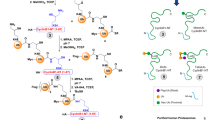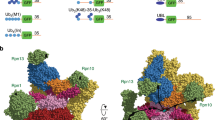Abstract
Proteolysis is essential for the execution of many cellular functions. These include removal of incorrectly folded or damaged proteins1, the activation of transcription factors2, the ordered degradation of proteins involved in cell cycle control3, and the generation of peptides destined for presentation by class I molecules of the major histocompatibility complex4. A multisubunit protease complex, the proteasome5, accomplishes these tasks. Here we show that in mammalian cells inactivation of the proteasome by covalent inhibitors allows the outgrowth of inhibitor-resistant cells. The growth of such adapted cells is apparently maintained by the induction of other proteolytic systems that compensate for the loss of proteasomal activity.
This is a preview of subscription content, access via your institution
Access options
Subscribe to this journal
Receive 51 print issues and online access
$199.00 per year
only $3.90 per issue
Buy this article
- Purchase on Springer Link
- Instant access to full article PDF
Prices may be subject to local taxes which are calculated during checkout






Similar content being viewed by others
References
Etlinger, J. D. & Goldberg, A. L. Asoluble ATP-dependent proteolytic system responsible for the degradation of abnormal proteins in reticulocytes. Proc. Natl Acad. Sci. USA 74, 54–58 (1977).
Palombella, V. J., Rando, O. J., Goldberg, A. L. & Maniatis, T. The ubiquitin-proteasome pathway is required for processing the NF-κB1 precursor protein and the activation of NF-κB. Cell 78, 773–785 (1994).
Glotzer, M., Murray, A. W. & Kirschner, M. W. Cyclin is degraded by the ubiquitin pathway. Nature 349, 132–138 (1991).
Rock, K. L.et al. Inhibition of the proteasome block the degradation of most cell proteins and the generation of peptides presented on MHC class I molecules. Cell 78, 761–771 (1994).
Coux, O., Tanaka, K. & Goldberg, A. Structure and functions of the 20S and 26S proteasomes. Annu. Rev. Biochem. 65, 801–847 (1996).
Seemuller, E.et al. The proteasome from Thermoplasma acidophilum : A threonine protease. Science 268, 579–582 (1995).
Löwe, J.et al. Crystal structure of the 20S proteasome from the Archaeon T. acidophilum at 3.4å resolution. Science 268, 533–539 (1995).
Omura, S.et al. Lactacystin, a novel microbial metabolite, induces neuritogenesis of neuroblastoma cells. J. Antibiot. 44, 113–116 (1991).
Fenteany, G.et al. Inhibition of proteasome activities and subunit-specific amino-terminal threonine modification by lactacystin. Science 268, 726–730 (1995).
Dick, L. R.et al. Mechanistic studies on the inactivation of the proteasome by lactacystin. J. Biol. Chem. 271, 7273–7276 (1996).
Groll, M.et al. Structure of 20S proteasome from yeast at 2.4 å resolution. Nature 386, 463–471 (1997).
Bogyo, M.et al. Covalent modification of the active site Thr of proteasomeal β-subunits and the E. coli homolog HslV by a new class of inhibitors. Proc. Natl Acad. Sci.. USA 94, 6629–6634 (1997).
Nandi, D., Woodward, E., Ginsburg, D. B. & Monaco, J. J. Intermediates in the formation of mouse 20S proteasomes: implications for the assembly of precursor beta subunits. EMBO J. 16, 5363–5375 (1997).
Driscoll, J., Brown, M. G., Finley, D. & Monaco, J. J. MHC-linked LMP gene products specifically alter peptidase activities of the proteasome. Nature 365, 262–264 (1993).
Gaczynska, M., Rock, K. L. & Goldberg, A. γ-Interferon and expression of MHC genes regulate peptide hydrolysis by proteasomes. Nature 365, 264–267 (1993).
Craiu, A. C.et al. Lactacystin and clasto-lactacystin β-lactone modify multiple proteasome β subunits and inhibit intracellular protein degradation and MHC class I antigen presentation. J. Biol. Chem. 272, 13437–13445 (1997).
Bai, A. & Forman, J. The effect of proteasome inhibitor lactacystin on the presentation of transporter associated with antigen processing (TAP)-dependent and TAP-independent peptide epitopes by class I molecules. J. Immunol. 159, 2139–2146 (1007).
Vinitsky, A.et al. The generation of MHC class I-associated peptides is only partially inhibited by proteasome inhibitors: involvement of non-proteasomal cytosolic proteases in antigen processing? J. Immunol. 159, 554–564 (1997).
Hilt, W. & Wolf, D. H. Proteasomes of the yeast S. cerevisiae : genes, structure and function. Mol. Biol. Rep. 21, 3–10 (1995).
Ghislain, M., Udvardy, A. & Mann, C.et al. S. cerevisiae 26S protease mutants arrest cell division in G2/metaphase. Nature 366, 358–362 (1993).
Gordon, C., McGurk, G., Dilion, P., Rosen, C. & Hastie, N. D. Defective mitosis due to a mutation in the gene for a fission yeast 26S protease subunit. Nature 366, 355–357 (1993).
Tamura, T.et al. Tricorn protease — the core of a modular proteolytic system. Science 274, 1385–1389 (1996).
Kettner, C. & Shaw, E. Inactivation of trypsin-like enzymes with peptides of arginine chloromethyl ketone. Meth. Enzymol. 80, 826–842 (1981).
Drexler, H. C. A. Activation of the cell death program by inhibition of proteasome function. Proc. Natl Acad. Sci. USA 94, 855–860 (1997).
Hershko, A. & Ciechanover, A. The ubiquitin system for protein degradation. Annu. Rev. Biochem. 61, 761–807 (1992).
King, R. W., Jackson, P. K. & Kirschner, M. W. Mitosis in transition. Cell 79, 563–571 (1994).
Sheaff, R. & Roberts, J. M. End of the line: proteolytic degradation of cyclin-dependent kinase inhibitors. Chem. Biol. 3, 869–873 (1996).
Hammerling, G. J., Rusch, E., Tada, N., Kimura, S. & Hammerling, U. Localization of allo-determinants on H-2b determined with monoclonal antibodies and H-2 mutant mice. Proc. Natl Acad. Sci. USA 79, 4737–4741 (1982).
Ljunggren, H.-G.et al. Empty MHC class I molecules come out in the cold. Nature 346, 476–480 (1990).
Acknowledgements
This work was supported by grants from the NIH and Boehringer Ingelheim. R. G. is a fellow of the The Swedish Foundation for International Cooperation in Research and High Education (STINT) Stockholm.
Author information
Authors and Affiliations
Corresponding author
Rights and permissions
About this article
Cite this article
Glas, R., Bogyo, M., McMaster, J. et al. A proteolytic system that compensates for loss of proteasome function. Nature 392, 618–622 (1998). https://doi.org/10.1038/33443
Received:
Accepted:
Issue Date:
DOI: https://doi.org/10.1038/33443
This article is cited by
-
An adaptive stress response that confers cellular resilience to decreased ubiquitination
Nature Communications (2023)
-
TRBP ensures efficient Dicer processing of precursor microRNA in RNA-crowded environments
Nature Communications (2016)
-
Nelfinavir augments proteasome inhibition by bortezomib in myeloma cells and overcomes bortezomib and carfilzomib resistance
Blood Cancer Journal (2013)
-
Targeted elimination of breast cancer cells with low proteasome activity is sufficient for tumor regression
Breast Cancer Research and Treatment (2013)
-
Stress regulation of the PAN–proteasome system in the extreme halophilic archaeon Halobacterium
Extremophiles (2012)
Comments
By submitting a comment you agree to abide by our Terms and Community Guidelines. If you find something abusive or that does not comply with our terms or guidelines please flag it as inappropriate.



